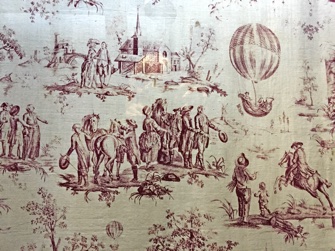
Not everyone may know what it is called, but everyone has seen the pretty ecru fabric with delicate pastoral scenes printed on it, usually in red or blue. This is Toile de Jouy, so-called not because it originated in Jouy-en-Josas, France (it was made in many countries) but because the most famous manufacturer was located there. Today, the town is staging a number of events to celebrate the two hundredth anniversary of the death of the founder of the Manufacture de Toiles de Jouy, Christophe Philippe Oberkampf (1738-1815), a German who made his fortune in France and transformed the then-artisanal process of making the fabrics with industrial practices and modern chemistry.
At the Musée de la Toile de Jouy, 12 Indian contemporary artists present their take on the history of the fabric in a special exhibition, “Le Tapis Moghol, une Tradition Réinventée,” organized in collaboration with the Akar Prakar Gallery of Calcutta. Toile de Jouy was originally inspired by Indian chintzes (called “indiennes” in France in the 17th and 18th centuries), printed with flowers and animals and imported to France beginning in the late 17th century. To quash competition with the domestic textile industry, Louis XIV banned the import and manufacture of these fabrics, and when the ban was lifted in 1759, foreign producers with the required expertise moved to France, one of them being Oberkampf, whose business grew into the biggest in the country. He not only became a citizen and mayor of Jouy-en-Josas but also managed to survive the Revolution, prosper under the Consulate and receive a Legion of Honor from Napoleon. The fall of the Empire brought with it, however, the failure of his business.
Meanwhile, the rise of the industry in France had decimated that of India, whose fabric industry has since made a comeback. The works by the contemporary artists comment on this back and forth between their country and Europe. My favorite piece was Archana

Hande’s “The Silk Route Hedges,” a sort of accordeon-pleated book tracing in delicate illustrations the passage over the Silk Route of fabrics on their way to Western wardrobes
Upstairs, another exhibition, “On the Toile,” offers more reinterpretations by artists and designers of Toile de Jouy in a variety of media: a Toile de Jouy dress by Jean Paul Gaultier for Hermès; “Shooting Wallpaper” by Brigitte Zeiger, in which a figure in a projected pastoral scene comes to life, raises a pistol, takes aim and shoots at the viewer; “Brooklyn Toile,” with scenes inspired by the New York borough (Brooklyn Bridge, Coney Island, etc.) by the agency Revolver New York; and “Harlem Toile,” designed by Artist Sheila Bridges for her own use, which satirizes stereotypes of blacks in America.
The museum’s permanent exhibition takes visitors through the history of Toile de Jouy and shows how the styles changed over the years, celebrating popular events (e.g., the first hot-air-balloon flight in Paris in 1783), and adapting to trends and politics of the day.

After Bastille Day, for example, Oberkampf continued to use fabric printed with the image of Louis XVI, but converted the king’s role from “protector of religion” to “protector of liberty.” Some of the patterns are still used today, like those commonly identified with Provence, which actually originated in Jouy-en-Josas. One mystery remains: the origin of the “coquecigrues,” strange, rather adorable half-animal, half-plant creatures

decorating some of the fabrics. In 1534 Rabelais used the expression “à la venue des coquecigrues” (“when the coquecigrues come”) in Gargantua, meaning “never.”
Another interesting exhibition (open by appointment only) of contemporary artists’ interpretations of Toile de Jouy, “On the Campus,” is being held in the gallery of HEC, a business school in Jouy-en-Josas with an American style campus. One work, Sharon Kivland’s “Pastorale-Nous Deux,” presents a traditional Toile de Jouy motif on the wall but subtracts the male figures from the couples, leaving the females in awkward positions: reaching out for a man who is not there, for example.
Click here for a full list of events being held to celebrate the bicentennial of Oberkampf in Jouy-en-Josas, a pretty, leafy town that is easy to get to from Paris and worth a visit. The gift shop in the Musée de la Toile de Jouy, by the way, has a great number of clever objects inspired by the famous fabric, ranging from jewelry to a bicycle seat cover and a pretty shopping basket.
Musée de la Toile de Jouy: Château de l’Églantine, 54, rue Charles de Gaulle 78350 Jouy-en-Josas. RER C, direction Versailles-Chantiers, to Jouy-en-Josas. Tel: 01 39 56 48 64. Open Tuesday, 2pm-6pm, Wednesday-Sunday, 11am-6pm. Closed Monday. Admission: €7 with temporary exhibition. Exhibition through July 26. www.museedelatoiledejouy.fr
Favorite